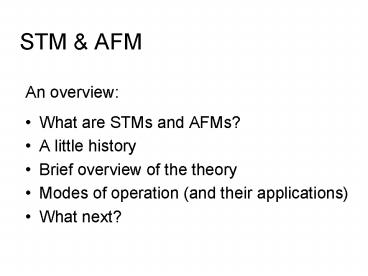STM
1 / 10
Title: STM
1
STM AFM
An overview
- What are STMs and AFMs?
- A little history
- Brief overview of the theory
- Modes of operation (and their applications)
- What next?
2
What are STMs AFMs?
Scanning Tunneling Microscope
Atomic Force Microscope
3
A little history
- pre-1930s
- Shine light on a sample to magnify its image.
Resolution is limited by l 4000 Å - 1920s (Ruska, Nobel 1986) used electrons to
image samples - What about feeling along a surface?
- 1970s (Young) first non-contact feeler-scope
- 1980s
- (Binnig and Rohrer, Nobel 1986) first stable STM
- (Binnig and Quate) first AFM
4
Theory I Quantum Barrier
Potential barrier
Schroedingers equation of motion
Electron (mass m, energy E) has finite
probability of tunneling through
5
Theory II Tunneling Current
- Applied voltage bias, V
- Tunneling electron gains energy eV
- Number of electrons that can tunnel depends on
occupation on each side
z
6
Modes of Operation
Constant-Current Mode
Constant-Height Mode
- Tip height is constant an x-y scan reveals a
topographic image of the surface. - better vertical resolution
- slower scanning may yield overall drift in x-y
scan - can be used for surfaces that arent atomically
flat
- Tip height is kept constant and tunneling current
is monitored. - very fast scans, reduces image distortion
- lower vertical resolution
- allows study of dynamic processes
7
STM Images
Standing waves caused by defects in copper
Iron on copper patterned assembled using STM tip
8
AFM Operation
Forces between the tip and sample deflect the
cantilever. Lennard Jones potential
- short-range repulsive (contact mode)
- long-range attractive (non-contact mode)
- force present in all materials no longer
limited to studying metals/semiconductors! - force parameters (e and s) are composition
dependent can map chemical variations - allows new measurements of biological samples,
even liquid submerged samples!
9
AFM Images
CD surface depth of groove 150 nm, bit width
2.5 mm, track spacing 2.5 mm
Sperm head helix pitch 650 nm, diameter 480
nm, length up to 40 mm
Hippocampus neural network 15 x 15 mm
10
The future of STM AFM
- develop better tip models
- effects of chemical composition, shape and size
- improved tip fabrication
- currently, very poor tip shapes, but still 1 atom
tip - predefined geometry?
- Limitations
- Finite size of tip distorts imaging of narrowly
separated atoms































